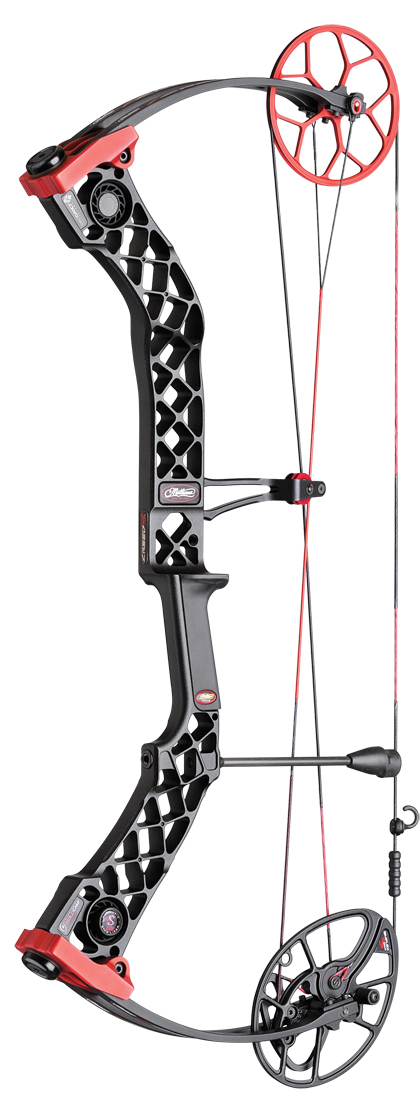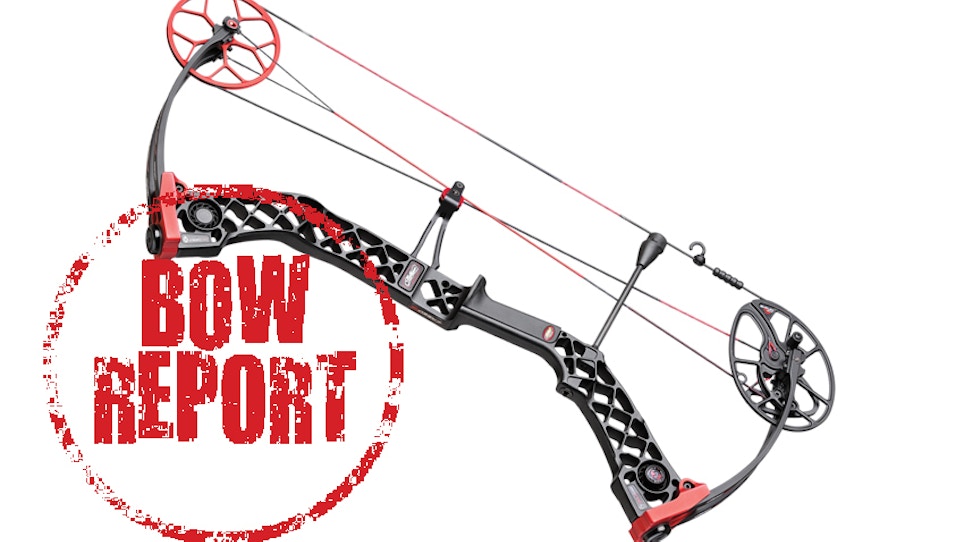It’s not news that the Creed garnered a lot of attention last year; every new introduction from Mathews garners a lot of attention. The obvious question with regard to the current incarnation, the Creed XS, is how does it compare to the original Creed?
The similarities are obvious, beginning with the SimPlex Cam system featuring an oversized cam and idler wheel. The size is an important design  feature, arguably more so in the case of the Creed XS than was the case for the Creed. The reason is that (particularly at longer draw lengths) the oversize cams create less string pinch and tension. This not only makes for a smoother and more efficient draw cycle, it also allows the shorter-axle-to-axle Creed XS (28 inches as opposed to 30 inches for the original Creed) to shoot with the feel of a longer-axle-to-axle bow.
feature, arguably more so in the case of the Creed XS than was the case for the Creed. The reason is that (particularly at longer draw lengths) the oversize cams create less string pinch and tension. This not only makes for a smoother and more efficient draw cycle, it also allows the shorter-axle-to-axle Creed XS (28 inches as opposed to 30 inches for the original Creed) to shoot with the feel of a longer-axle-to-axle bow.
The split quad limbs, a new feature for Mathews single-cam bows on the Creed, are back for 2014 on the Creed XS, as are the harmonic dampers, Geo Grid Lock Riser, Dead End String Stop Lite, and Mathews signature walnut grip. Also back is the Reverse Assist Roller Guard. By simply positioning the cables in front of the roller guard (instead of the more conventional location behind the roller guard), friction and tension are reduced, contributing to greater efficiency, a smoother draw cycle, and reduced torque.
There is a small hole in the SimPlex Cam to serve as a cam orientation guide. When the cam is properly oriented, the cable can be seen through that hole when the bow is held to the side.
So what’s different? Mathews touts the XS as “smoother, lighter, and quieter” than the original Creed. Certainly the specs are different. Most significantly, the XS is, as previously mentioned, more compact than the Creed. And yes, it is a shade lighter at a published 3.8 pounds as opposed to 3.85 pounds. Finally, the brace height is wider at 7.5 as opposed to 7 inches. Many shooters prefer a longer brace height and perceive this feature as more forgiving. Certainly it is more forgiving for shooters who, because of anatomy, shooting form, or a preference for heavy hunting coats, tend to have problems with the string slapping their arm. In any case, this leads to another difference between the Creed and the Creed XS—the XS is about 7 fps slower than the Creed, a disparity that is mostly, if not entirely, attributable to the difference in brace height.
Fit and finish has never been an issue for Mathews bows, and the Creed XS is certainly no exception. The Zebra Trophy string, along with the roller guards, harmonic dampers, and a few small and subtle logos, are bright red in vivid contrast to the riser, limb, and cams.
Shooting The Bow
I’m sure most bowhunters will find that tuning a Mathews bow is generally an easy and straightforward process. I squared the arrow and installed the rest at the Mathews standard 13/16 inches from the riser. I made a few micro-adjustments in and out (mostly in) to shoot bullet holes through paper with unfletched arrows, then sighted in quickly at 20 yards.
The light weight of the Creed XS is one of its more immediately noticeable properties, along with its compact size. Grip is a very personal and subjective issue; what I like about Mathews’ walnut grips, apart from their comfort and warmth in cold weather, is that they are slick, a quality that (at least when used in conjunction with the right glove) I believe reduces any tendency to torque the bow at the shot.
It would be headline news if a Mathews single-cam bow were not smooth-shooting. Smooth is what they are all about, and the Creed XS is a smooth bow among smooth bows, as the draw force curve indicates. It’s a bow that encourages extended shooting sessions, and extended shooting sessions provide the kind of muscle memory that makes for consistent shooting form, which translates to accuracy.
Another nice Creed XS bow feature that contributes to consistent form, and something that is lacking on some single-cam bows, is the solid draw stop that provides a very solid back wall. The Creed XS, as with its predecessor, comes with an alternate draw stop, which is skinnier than the draw stop installed. Replacement is very easy and requires no tools. Shooters who prefer a wider valley might prefer it. I did, but the difference is slight. At the shot there is no hand shock or vibration, and the bow is quiet. (I found that even without a stabilizer, there was only the smallest amount of perceivable vibration at the shot.)
At 321 fps, the Creed XS is not the fastest bow on the planet, nor was it designed to be. Is it fast enough? If putting an arrow all the way through a whitetail and sticking it in a tree on the other side is fast enough, 321 fps will do that every time with a good broadhead and even fairly light arrows. The Creed XS is all about shootability, compact size, and light weight. If maximum speed is something you insist on, there are blazing-fast bows out there. But if accuracy, smooth and pleasant shooting, and quiet are high on your list of priorities, and if you are among the many bowhunters who find there is nothing to match the feel of a single-cam bow, if you prefer a compact-axle-to-axle bow, and if you value light weight in a bow, you’ll find a lot to like and nothing to dislike in the Creed XS.
Mathews Creed XS Specs
Letoff: 80%, adjustable down to 65%
Brace Height: 7.5 inches
Weight: 3.8 pounds
Axle-To-Axle Length: 28 inches
Speed: 321 fps
Draw Lengths: Module-specific, adjustable from 26 to 30 inches in half-inch increments, press required
Draw Weights: 50, 60 and 70 pound peak, adjustable down 10 pounds from peak
Options: Finishes in Lost Camo, Desert Tactical, Black, Black Tactical, Crimson
Suggested Retail: $999
Objective Tests (30 Inches Draw)
Peak Hold*: 70 pounds
Weight, Full Draw*: 17.2 pounds
*Rounded to nearest half-pound
At 70-Pound Draw Weight
| Arrow Weight | Speed @ Launch | Speed @ 20 Yards | K.E. @ Launch | K.E. @ 20 Yards |
| 385 grains | 294 fps | 283 fps | 74.0 ft. lbs. |
68.5 ft. lbs. |
| 500 grains | 261 fps | 252 fps | 75.5 ft. lbs. | 70.5 ft. lbs. |
At 60-Pound Draw Weight
| Arrow Weight | Speed @ Launch | Speed @ 20 Yards | K.E. @ Launch | K.E. @ 20 Yards | Sound Level |
| 385 grains | 271 fps | 261 fps | 63 ft. lbs. | 58 ft. lbs. |
60.1 dBA |
| 500 grains | 239 fps | 231 fps | 63.5 ft. lbs. | 59 ft. lbs. | 58.2 dBA |







